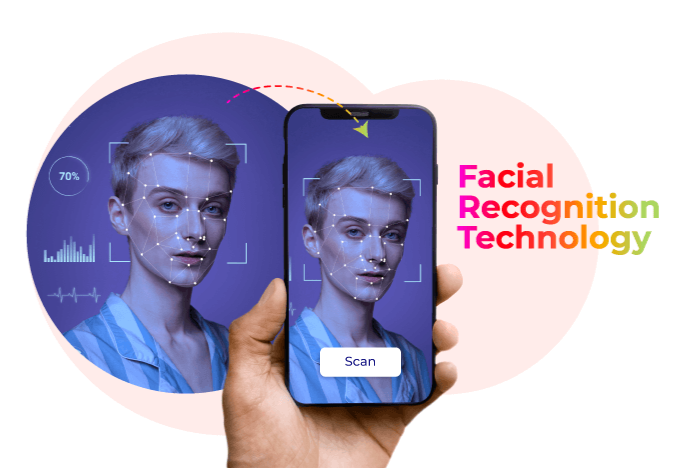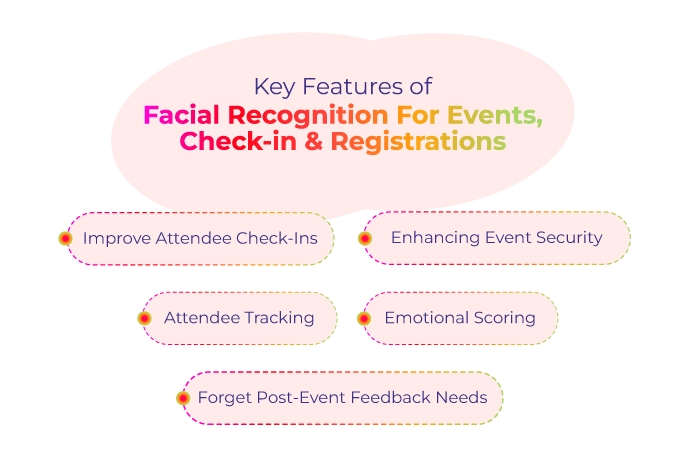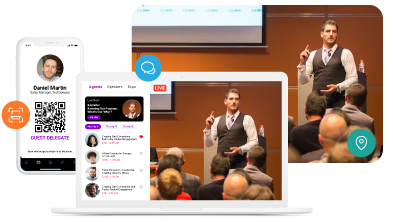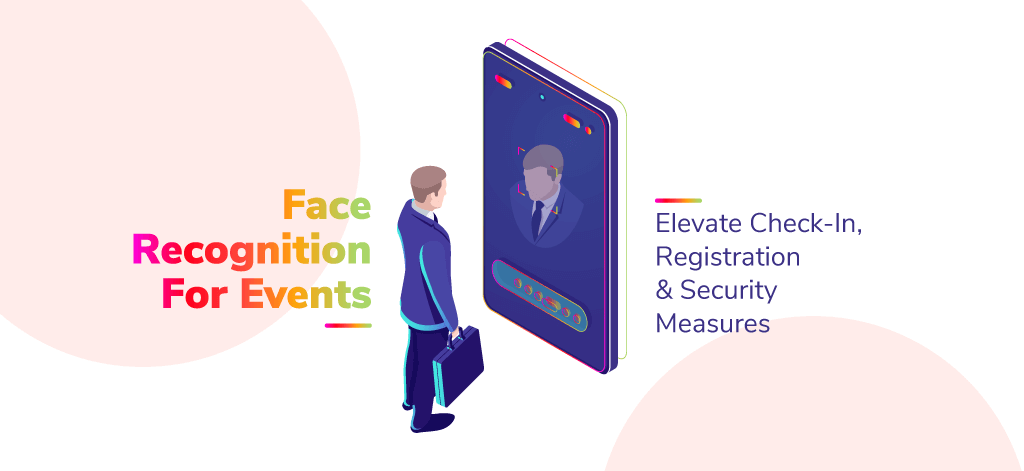Facial recognition technology is no longer a futuristic innovation for which we need to wait. It has become a prevalent tool in various industries, proving its effectiveness in tasks such as unlocking phones and managing corporate office attendance. Moreover, the technology is already being utilized in conferences, trade shows, expos, fairs, and other large-scale events. Facial recognition for events technology plays a significant role in enhancing check-in procedures, registration processes, ticketing systems, and overall event management. It effectively streamlines the entire process, marking a notable advancement in event technology.
It has been globally proven that face-recognition event check-in and registrations greatly enhance efficiency and promote security within the event industry. Furthermore, the ability to obtain real-time analytics regarding crowd flow and attendee tracking has enticed organizers to adopt face recognition event check-in technology. In this blog, we will delve into the key features, benefits, functioning, and other essential aspects of facial recognition event registration. Let us now embark on a detailed exploration of this innovative technology.
What Really is Facial Recognition Technology?
Facial recognition technology refers to a biometric application that captures and stores the unique facial features of individuals, enabling real-time analysis when required. In essence, it serves as a security mechanism that allows individuals to utilize their facial features as a form of identification, replacing the need for traditional methods such as RFID technology for events, cards, badges, event ticketing platforms, or fingerprints. It is often referred to as a facial fingerprint.

But from this definition, we just get an idea of what facial recognition event registration is. However, in the context of the event industry, facial recognition event registration is a bit different from it. But uses the same technology and innovative approach to distinguish.
What is Facial Recognition for Events Technology?
Every day, small to large events are organized, and facial recognition for events technology is employed to streamline the event check-in process, registrations, and facilitate attendee tracking. So, what is it exactly? It is simply the same technology that is used wherein any individual, during the registration process, uploads their photo (which is later saved in the database). On the day of the event, participants can use this technology to verify their authentication. This approach benefits both the attendees, as it significantly reduces the time required for verifying identification, enhances security, and provides a hassle-free registration and check-in process.
From the above definition of facial recognition for events, it is clear that this technology is the potential to have great significance. But do you know how big the market for its face recognition event ticketing technology is? Before we start learning about its features and benefits. Let’s explore the facial recognition industry.
The Facial Recognition Industry
The facial recognition industry is experiencing significant growth and is expected to continue expanding in the coming years due to its numerous associated benefits. According to a report in 2019, the global market for face registration for event ticketing was valued at approximately 7 billion USD and is projected to reach 19 billion USD by 2025. In India, the estimated market size for face-based event access technology is USD 280 million in 2022.
This technology is extensively utilized by major government agencies and military forces for surveillance purposes, while various institutions such as corporations, universities, schools, and others employ it for biometric attendance tracking. The data and figures clearly demonstrate the substantial size of the market, and as the demand continues to rise, many industries, including the event tech industry, have adopted face registration for event ticketing. Now, let’s explore how this technology is utilized in corporate events, trade shows, expos, fairs, conferences, and other large or small-scale events.
Now, as we learned about its market, it is time to explore a few more important aspects of it. So why wait to, start exploring the next section;
Deploy Facial Recognition for Events to Simplify Attendee Check-in & Registrations
There is no need to go through a major hassle when it comes to deploying facial recognition for event attendees at your next event. By simply hiring an event techs suite like Dreamcast or any other service provider, you can easily accomplish this. Additionally, to implement this solution, you can request your attendees or registrants to submit a photo of their faces during the RSVP process, (which serves as another way to confirm their attendance). The submitted photos are then uploaded to the database, and the face recognition event check-in applications take care of the rest. On the day of the event, as attendees pass through the check-in stations, the system will automatically verify and authenticate their identities by comparing their faces with the photos saved in the database. It will display an error message for unauthorized or unregistered participants, ensuring a streamlined and secure check-in process.
Doing face-based event registration is fine, but before deploying the facial recognition for events technology. Let your attendees feel comfortable about it. It is not completely normal to feel a bit odd about any new technology. As not everyone is friendly about adopting technology. So, address their all concerns before doing it.
Make Attendees’ Concerns about Facial Recognition Events Merely Concerns, Not Serious Worries
As technology continues to advance, there is often fear among people when it comes to adopting new technologies. While younger individuals who have used face recognition features on their phones may feel comfortable, some older individuals may find it invasive. To ensure that everyone feels at ease, it is important to address the privacy protection of facial recognition for event applications. Make it easier for you, we have compiled a list of questions that potential guests may have regarding face recognition event check-in technology:
- To whom are my submitted photo and facial fingerprint data accessible?
- What level of security is implemented to safeguard this information?
- What is the duration for which my data will be retained?
- What purposes or applications are there for my facial fingerprint data once the event concludes?
To address these concerns, you can assure attendees that no actual photos are saved in the database, but rather, only a “facial fingerprint” algorithm is stored. Additionally, inform them that the company behind the facial recognition event registration technology prioritizes privacy and takes the protection of user data seriously. As a host, it is essential to be transparent about privacy policies and security measures.
Key Features of Facial Recognition for Events, Check-in & Registrations

There are many added advantages associated with contactless face check-in for events, like convenience and security are utmost. Besides that, it helps in gathering valuable actionable insights that potentially help event organizers to make informed decisions and streamline planning and real-time management. Let’s take a look at how facial recognition for event technology features help you in organizing events;
Improve Attendee Check-Ins
In a big event that is expected to have thousands of attendees, there can be a long waiting queue at the check-in stations. However, to eliminate such long lines, you can deploy face recognition for event check-in. This technology makes the process fast, simple, and easier. Moreover, face-based event registrations not only shorten the lines but also eliminate the need for attendees to carry printed tickets, badges, and IDs.
Additionally, participants don’t have to waste time searching for confirmation emails or QR-based badges. By simply scanning their faces, they can quickly gain access to the venue, a process that takes just a couple of seconds. The enhanced event check-in process represents one of the finest applications of facial recognition for access control management technology. Even if only 70% of your attendees choose to submit their photos, you can still expect a higher rate of improvement.
Enhancing Event Security: Unleashing the Power of Facial Recognition
Face-based event registration is an unparalleled solution to maximize security beyond conventional methods. Adopting biometric data as the standard security check-in eliminates all kinds of infiltration tactics such as borrowed IDs, acquiring someone’s else ticket, or other frauds. Even airport security is also standardized with facial recognition access control. Making it an authentic technology to be harnessed by event organizers to redefine security measures. Moreover, this is also valuable for virtual and hybrid events to safeguard unauthorized entry and eradicate potential disruption.
Not just the attendee check-in process or improved security, but there are some important analytics also, that face detection for event attendees technology comes with.
Attendee Tracking
As an event host, you can track your attendee movement in the event, like which session is attended by whom. The analysis of such insights is useful in making informed decisions and also takes you to the experience level of the attendees, their likes, dislikes, and others.
Emotional Scoring
You might not think of this earlier or at starting of this blog, but yes it’s true you can not track the attendees but also measure their satisfaction level. Well, this is an important characteristic of contactless face check-in for events technology. It let you recognize the attendee’s emotional reactions like sad, happy, excitement, shock, or other kinds of emotions.
In the events at different points, by deploying such cameras, you can record attendees’ reactions. Also, note down that which kind of fun engagement, or other interactive elements deployed by your team is liked or not. Making it easier for you to analyze the event’s overall aspects with context to attendee satisfaction.
Forget Post-Event Feedback Needs
With session attendee tracking and emotional scoring, there is no need to wait for post-event feedback. However, they are quite important, but it is observed that sometimes the feedbacks are biased and dishonest. But now with the face detection for event attendees technology, there is no need to do so, you yourself get the actionable analytics in real-time.
Contactless Face Check-in for Events: Elevate Your Events Standards & Taste the Success
As you have seen, facial recognition event registration technology is a robust tool that significantly expanding across industries. The potential, versatility, and numerous features to improve overall security, and efficiency and offer valuable insights can be a game changer for the event host. If you like to deploy this or other kinds of cutting-edge event tech solutions, book your free demo to learn more. We at Dreamcast offers all kinds of services and product support for event ranging from live streaming services, mobile event app, a microsite for online event registrations, WhatsApp business automation, 360-degree camera, social media walls, photobooth, gamification, and a lot more. Explore our website to learn more about our services, or simply get in touch with us.
FAQs
Facial recognition for events refers to a technology that uses facial features as the identity of the individual in order to authenticate event attendees. This is used to simplify the check-in process, improve security, and gather data about attendees.
On the event day, when the participants arrive and go through the check-in station point, the facial recognition scanner scan the facial feature of that person and identify whether to give access or not. This is done by comparing the pre-loaded database of faces of all registrants, if the attendee is in the database, they will be allowed to enter the event.
There are numerous benefits of using this technology such as streamlined check-in, improved security, data gathering, and attendee satisfaction the most crucial.
Like every technology, it does have a few concerns like privacy, accuracy, and cost. But all of these concerns are only just preconceived notions and are not true.
Create an Extraordinary Event Experience
Across All Event Formats




















